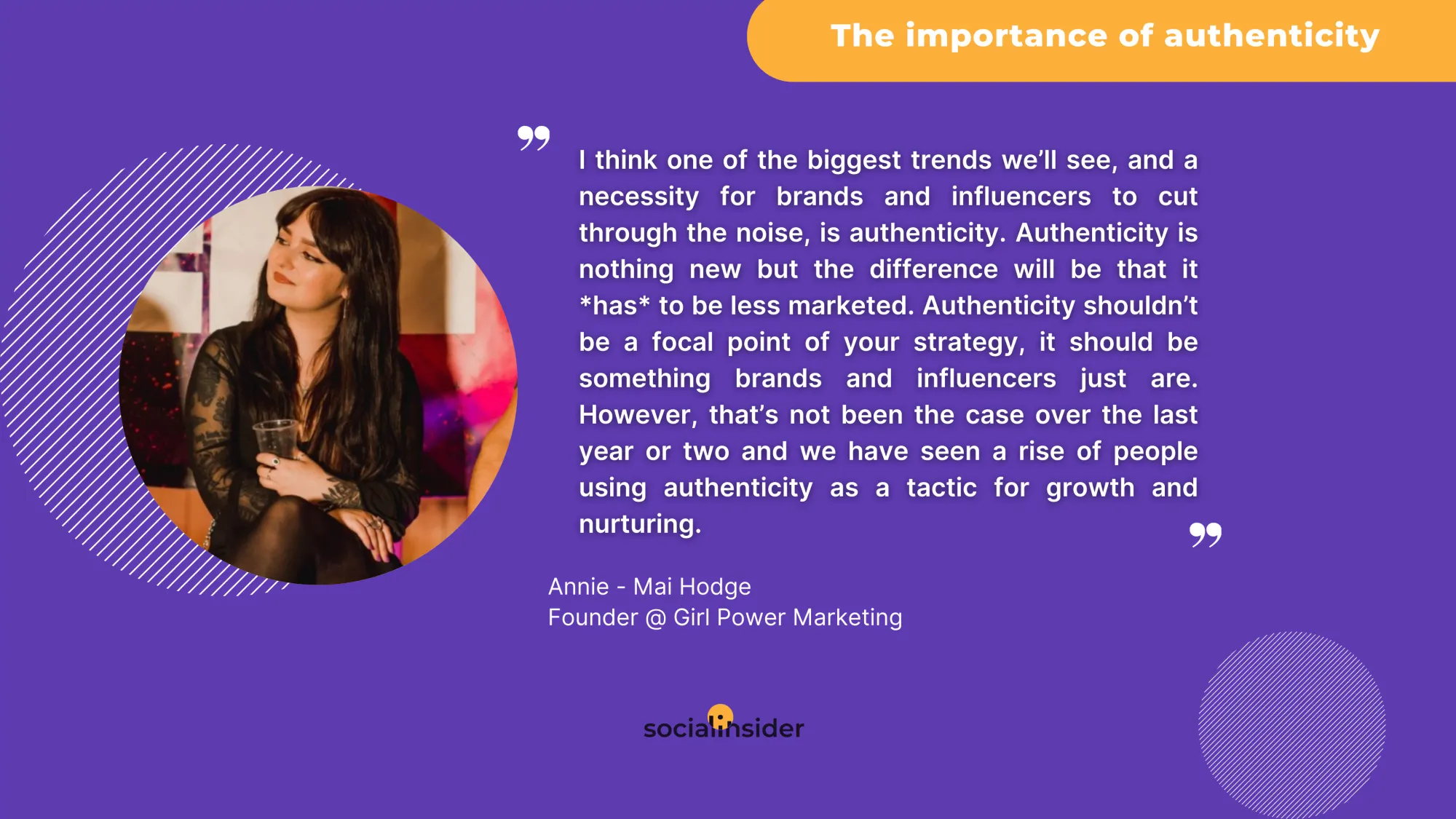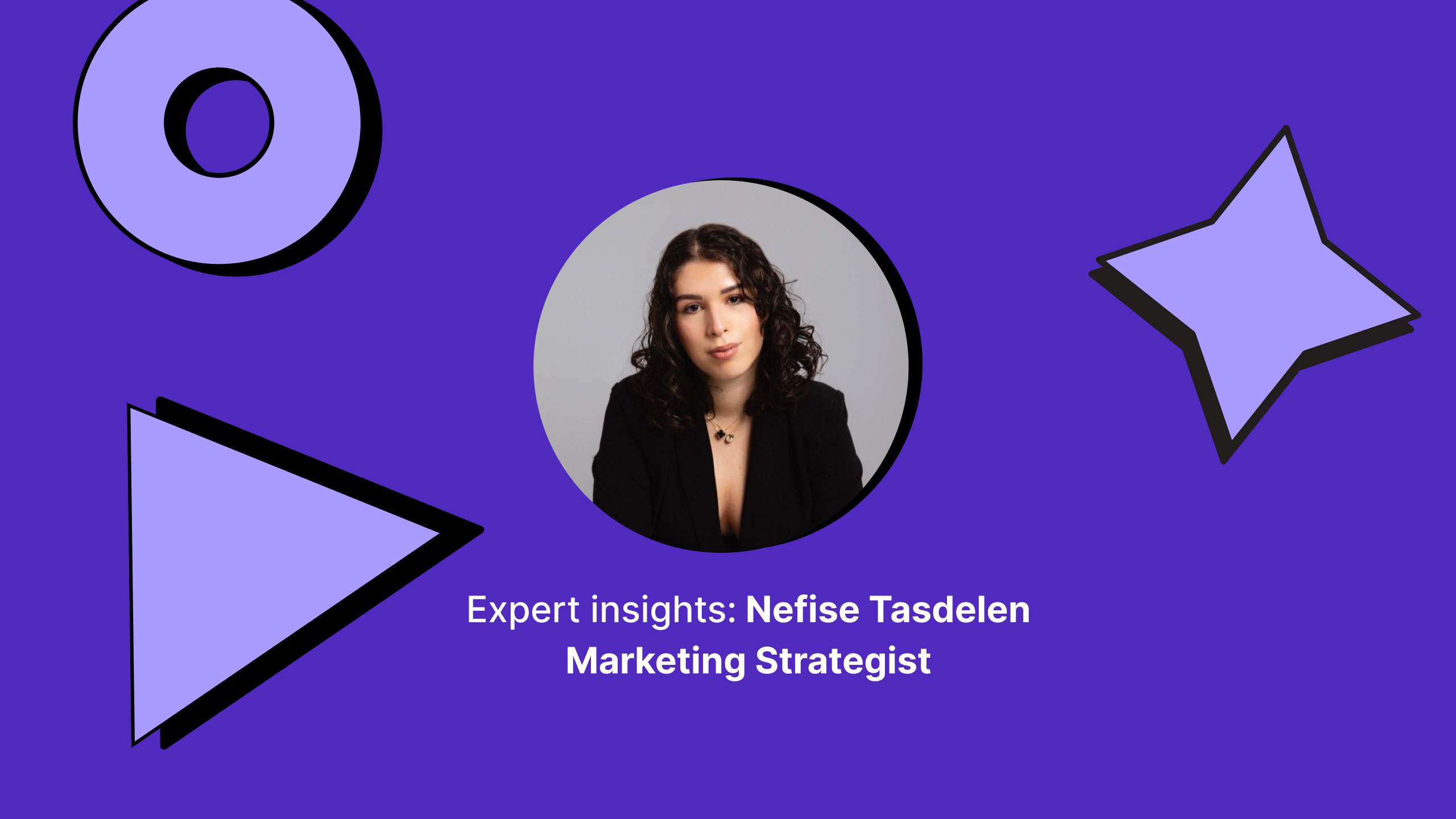Influencer Marketing: Your A-Z Guide
Influencer marketing connects brands with trusted creators for authentic promotion. Discover in this guide how to maximize influencer partnerships for your brand!


Influencer marketing is where the magic happens, and we’ve got all the info you need to play it right.
We’re diving into the what, why, and how of working with influencers, sharing the secrets to a top campaign that grabs attention and keeps it.
Plus, we’ll show you the dos, the don’ts, and the heck, yes! moments from brands that nailed it.
So whether you're new to the field or refining your current social media strategy, this guide on how to use influencer marketing has the inside scoop to help you own the social media marketing game.
What is influencer marketing?
Influencer marketing is a social media marketing approach where brands partner with trusted, well-known individuals to authentically promote products to their audiences.
This collaboration between influencers and brands boosts brand awareness and engagement without disrupting the user experience.
Why are influencers important?
With over 90% of marketers investing in influencer marketing each year, influencers’ effectiveness is undeniable.
By leveraging social proof, social media influencers bring a sense of authenticity that resonates more personally than traditional ads.
In fact, influencer-shared content can drive engagement rates up to 8 times higher than brand-generated posts, with an average return of $5.20 for every $1 spent, making it one of the most profitable marketing strategies available.
Benefits of using influencers for marketing
Using influencers in marketing offers brands key advantages, including:
Access to targeted audiences
Influencers connect brands directly with the audiences that matter most.
They’ve already curated followers who care about specific interests—like beauty, tech, fashion—making it easy to reach exactly who you need.
Expanded reach
With influencers on social media, brands get their message in front of way more eyes.
Influencers expand your visibility fast, boosting brand awareness by tapping into networks that might not have discovered you otherwise.
Increased brand trust and loyalty
People trust influencers they follow, seeing them almost like friends.
When they recommend a brand, it comes with built-in credibility, making audiences feel more loyal and connected to the brand.
Higher engagement
Influencers create excitement around your brand, driving social media engagement such as likes, comments, and shares.
Their followers are ready to interact, so your message doesn’t just reach people—it starts conversations.
Good ROI
Influencer marketing delivers a solid social media ROI, especially compared to traditional ads.
This way, by working with influencers in social media, you’re getting real interactions, genuine connections, and often higher conversion rates.
Influencer marketing vs affiliate marketing
Influencer marketing and affiliate marketing both involve working with external partners to enhance brand reach and drive growth.
But what are differences between the two?
Affiliate marketing focuses on sales through commission-based partnerships where affiliates earn a percentage based on each sale they help generate.
Basically, affiliates turn traffic into purchases, making it a more direct, revenue-driven approach.
Influencer marketing, on the other hand, focuses on elevating brand awareness and building a broader audience connection.
Influencers create engaging, authentic content to expose their followers to a brand, which can lead to sales as a secondary effect but is more concerned with nurturing brand recognition and trust over immediate conversions.
Here’s a table to give you a clearer view of the differences between influencer endorsements and affiliates:
Influencer and affiliate marketing can work together by having influencers act as affiliates, combining brand exposure with performance-based sales incentives.
This approach maximizes visibility and drives measurable sales, benefiting both the brand and influencer.
How to build an influencer marketing strategy?
Social media and influencer marketing go hand in hand, creating a dynamic way for brands to connect with their audiences.
In this section, we’ll guide you through the top influencer marketing tactics that drive results on social platforms.
So let’s set you up for impactful, effective partnerships.
#1. Set the objectives of the influencer marketing campaign
Defining your objectives gives you a reference point for assessing progress, ensuring that you won’t need to pivot mid-campaign due to unclear priorities.
When social media goals are clear and well-defined, your strategy becomes sharper and more effective.
Ideally, an influencer marketing campaign should concentrate on just one or two core objectives:
- Visibility: Collaborating with a diverse range of influencers can expand your reach and engage more people. For these campaigns, metrics like reach and engagement rate are critical for evaluating success.
- Branding: If your goal is to shape or reinforce your brand image, partnering with influencers who have niche, highly engaged audiences can make your brand more memorable and recognizable.
- Positioning: Aiming to be top-of-mind in your industry? Work with influencers to provide information about your brand’s unique qualities and benefits. This strategy fosters brand recognition and reinforces industry presence.
- Traffic: Driving traffic to your website can be done through influencer-led giveaways, competitions, or direct links. While this doesn’t guarantee an immediate purchase, it builds awareness and encourages future visits. Trackable links and URL clicks measure traffic effectively.
- Conversions: Often a primary campaign goal, conversions turn traffic into specific actions like sign-ups, app installs, or other user interactions. Defining what counts as a conversion helps measure the impact on your sales funnel.
- Sales: Use unique tracking links and discount codes with influencers to incentivize followers. This helps attribute sales directly to the influencer’s efforts and compensates them for driving revenue.
- Brand loyalty: Building loyalty among existing customers is just as important as attracting new ones. Brand ambassadors, or influencers with whom you have ongoing partnerships, can help retain followers over time. Competitions and user-generated content, such as customers sharing brand experiences, can further strengthen loyalty.
So remember, setting clear objectives is one of the best influencer marketing tactics because it provides direction and helps maintain focus.
#2. Decide on a budget
Deciding on a budget is a critical part of influencer campaign management because it ensures that resources are allocated effectively and the campaign goals can be realistically achieved.
A clear budget helps in determining the type and number of influencers that can be engaged, the scope and duration of the campaign, and the potential for reach and engagement within target markets.
Additionally, setting a budget allows for strategic planning, so funds are distributed efficiently across content creation, platform advertising, and any necessary contingencies.
Proper budgeting ensures that the investment yields optimal results, aligns with the brand's objectives, and remains sustainable for future campaigns.
#3. Determine the most effective influencer type for your brand
When developing an influencer marketing campaign, choosing the right types of social media influencers is essential for maximizing impact.
Influencers come in different categories based on the size of their following and their typical engagement rates.
As the table above shows, smaller influencers (nano and micro) generally offer higher engagement rates, making them ideal for creating brand trust and driving action.
Conversely, larger influencers (macro and mega) can deliver wider reach and impressions, allowing brands to increase awareness on a bigger scale.
Selecting the right types of influencers on social media
Selecting the right influencer type should depend on both the campaign’s budget and its primary objectives.
Budget:
Smaller influencers are typically more budget-friendly, so if a campaign has a limited budget, nano and micro-influencers are ideal. For larger budgets, macro and mega influencers are effective at creating mass awareness.
Campaign objective:
- Awareness: Macro and mega influencers are suitable when broad exposure is key, as they can reach millions of people.
- Engagement: For campaigns that rely on interaction (comments, likes, shares), nano and micro-influencers perform best due to their closer, more personal relationships with followers.
- Conversions: Micro and mid-tier influencers, who combine engagement and credibility, often drive more conversions.
Carefully matching the influencer type to these factors can help maximize the return on investment and effectively achieve campaign goals.
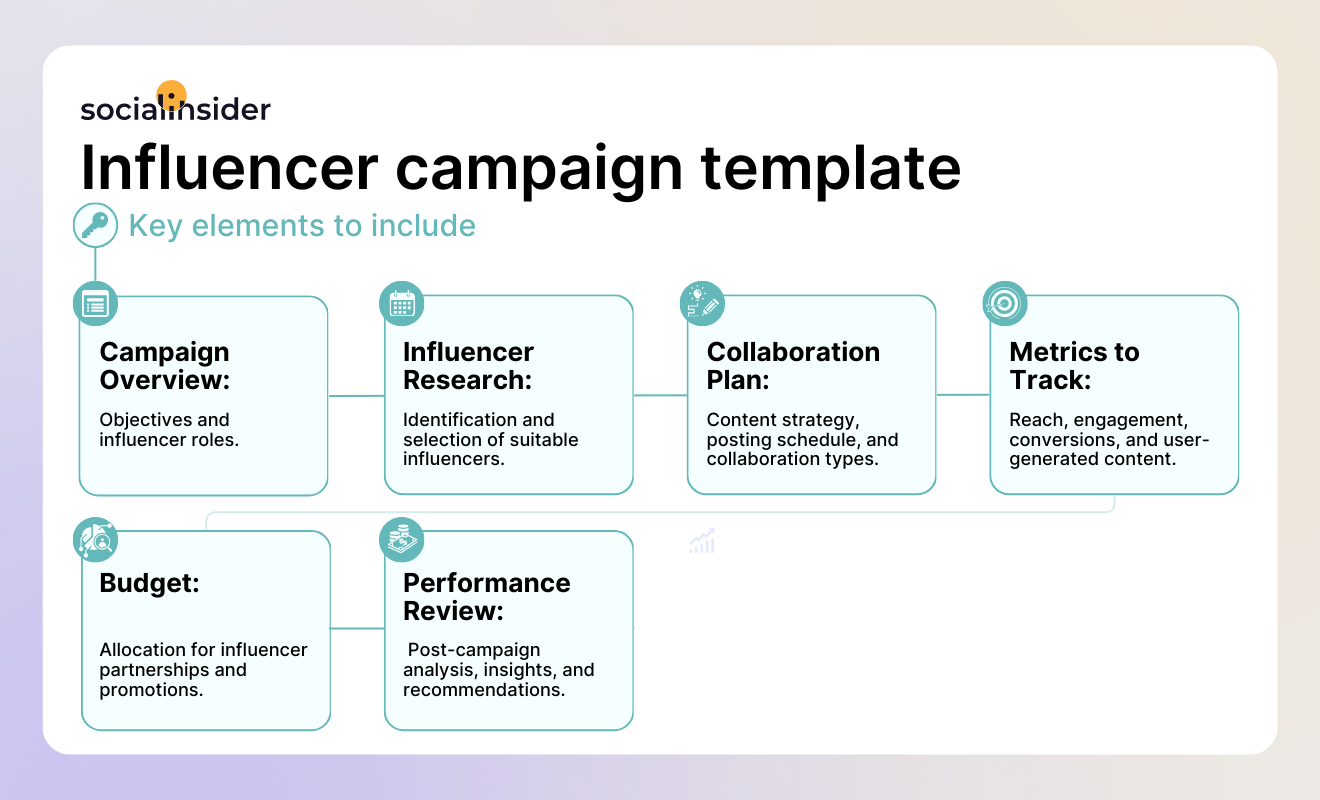
#4. Research influencers of interest
The power of influencer marketing lies in selecting the right influencers for your brand.
And now that you’ve settled on the type of influencer you want to work with—be it nano or macro, it’s time to dive deeper to find the perfect match.
Searching for the right influencers within your chosen category ensures alignment with your brand’s values and personality.
To find the best ones for your campaign, you can either conduct a manual search or use specialized tools like Klear, which streamline the process.
If you’re searching manually, start by exploring social media platforms where your audience is most active.
Use relevant hashtags, follow industry-related accounts, and check out brand mentions to discover influencers naturally aligned with your niche.
Review their posts, engagement quality, and recent collaborations to ensure authenticity and relevance.
Alternatively, third-party apps make it easier to filter influencers by category, location, follower count, engagement rate, and more.
These platforms provide a wealth of data, helping you quickly pinpoint influencers who fit your campaign’s values and target audience.
Whatever the method, remember to look at each influencer’s past collaborations and assess if their content aligns with your goals and product.
Review their content pillars—what topics do they focus on most—and see how actively engaged their audience is on those themes.
Notice if followers are commenting, sharing, or just passively liking.
By doing this groundwork, you’ll find the influencers who resonate with your brand and have an audience ready to connect.
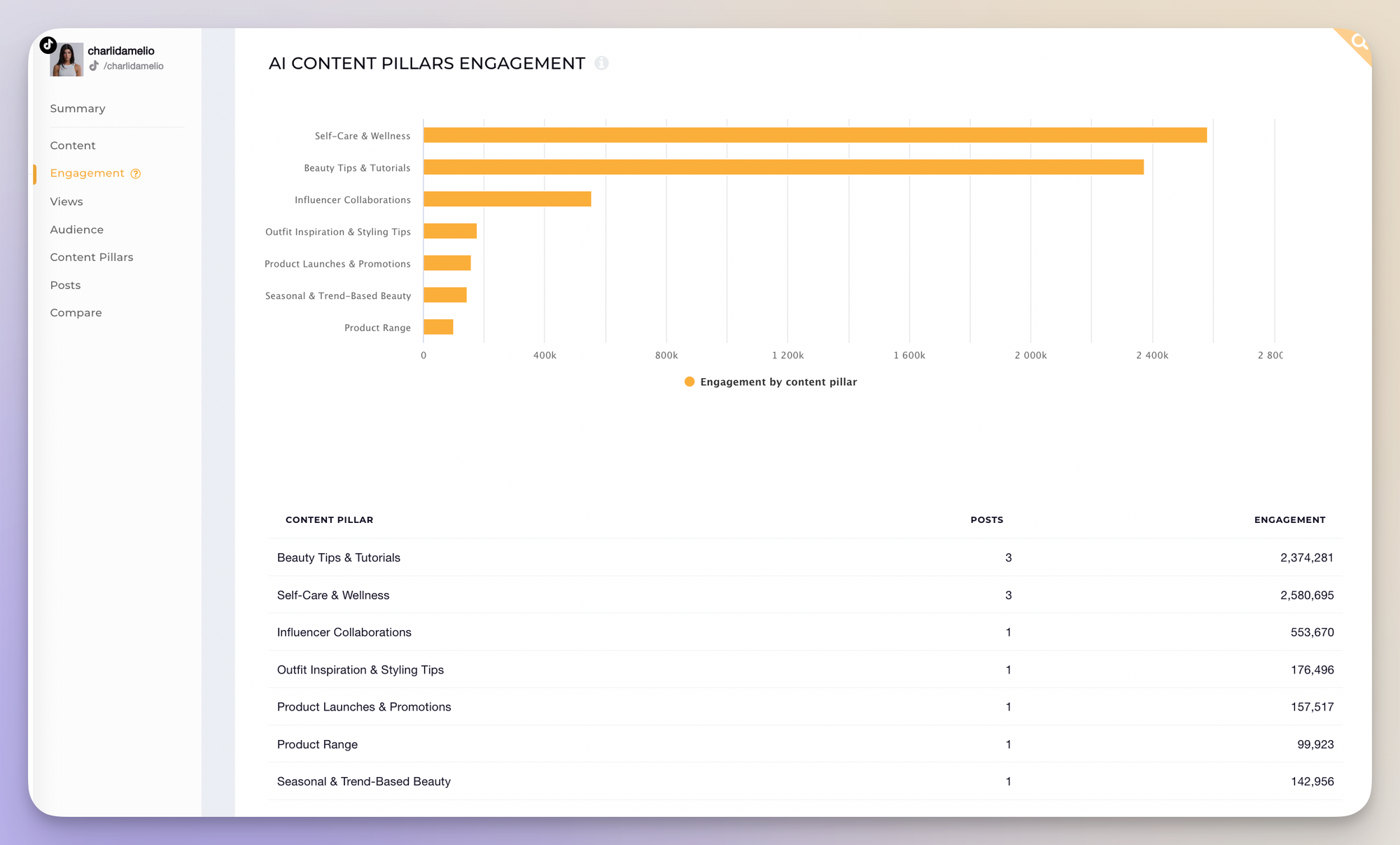
#5. Brief influencers on desired deliverables
To ensure your campaign is set up for success, providing influencers with a clear and detailed brief is essential—it’s the roadmap to achieving your goals and maximizing impact.
Here’s how each key element plays a role:
- Target audience: Outlining the target audience helps influencers understand exactly who they're speaking to. For example, sharing specifics like age range, interests, or lifestyle details allows influencers to better connect with your audience and make each post feel relevant and impactful.
- Content type: Detailing content types—be it a Reel, an engaging Story, or a carousel—gives a creative framework that respects their style while elevating brand messaging.
- Messaging direction: Sharing the messaging direction lets influencers tap into the brand's core vibe, making sure their voice and the brand's goals flow together. This thoughtful prep work helps create a smooth, impactful campaign.
- Number of posts: Let influencers know how many pieces of content you expect. For example, “two in-feed posts and three Stories” provides clarity on the content volume, helping influencers plan how they’ll showcase the brand without overwhelming their feed.
- Timing of posts: Specifying posting times and dates, especially for time-sensitive campaigns like product launches or holiday promotions, is crucial. For instance, “post your first Story two days before the launch and the main feed post on launch day at 12 PM” creates a strategic posting flow and ensures that the content aligns with key campaign moments.
- Posting cadence and duration: For campaigns that last over a period (e.g., a month-long series), set up a cadence such as “one post per week” to maintain steady engagement. Also, clarify if the posts should remain live indefinitely or for a minimum period, such as “keep the posts up for at least one month,” to maximize visibility.
- Usage rights and exclusivity: If you plan to repurpose content on your own channels, make sure influencers understand any required usage rights. Additionally, mention exclusivity terms if needed, like “no partnerships with other brands in [industry] for one month,” to keep the campaign focused.
Providing these details helps influencers plan their content effectively and ensures that the campaign runs smoothly, delivering maximum impact and value for both sides.
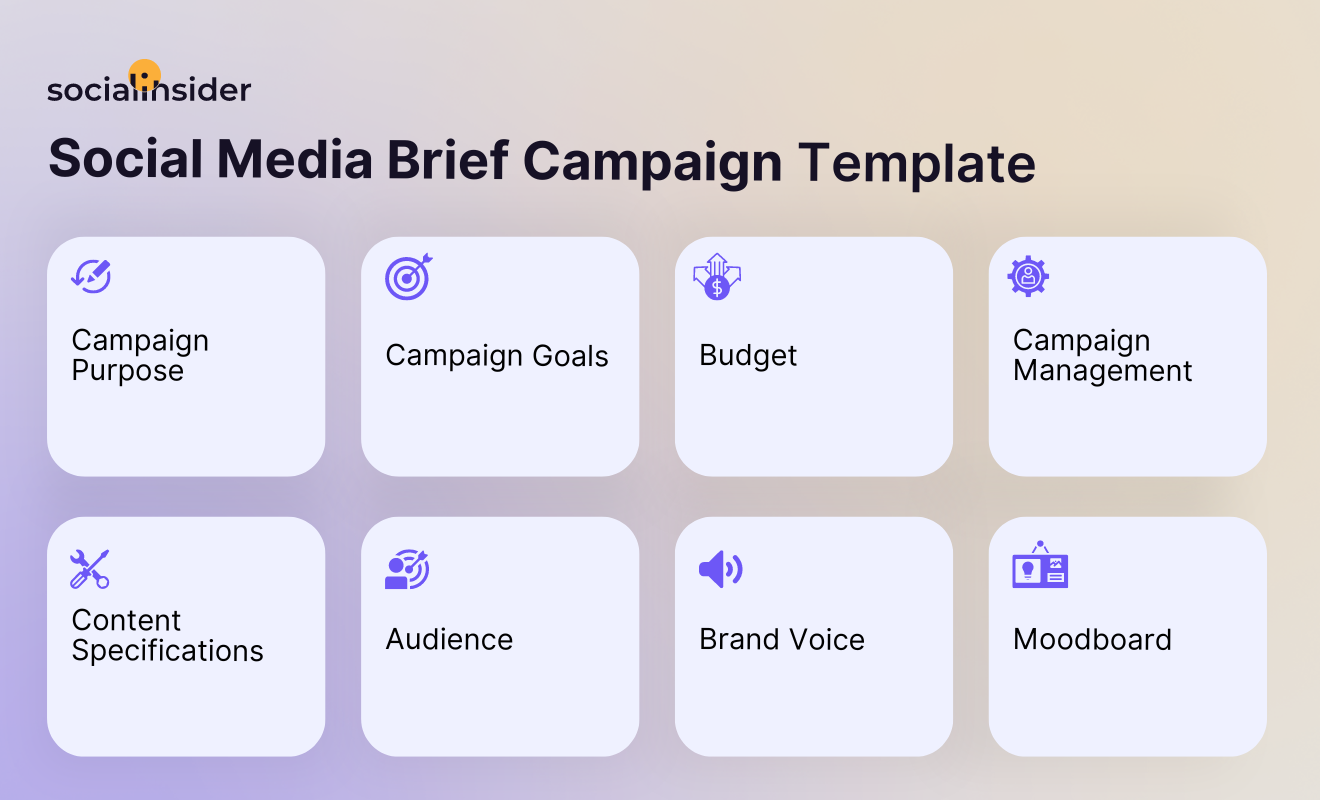
#6. Boost influencer content
Some might think the job’s done once influencer content is posted, but there’s a lot more potential just waiting to be tapped.
Boosting influencer content as video ads is a smart way to get even more eyes on what they’ve already created.
It’s an easy way to keep the momentum going on a piece of content that already connects with the audience, giving it the push it needs to reach its full potential.
#7. Measure your influencer marketing campaign results
Tracking the results of your influencer marketing campaigns is key to seeing what’s working and making smarter decisions.
By monitoring social media metrics like engagement, reach, and follower growth over the campaign timeframe, you can better understand whether it’s sparking the actions you’re aiming for.
This social media analysis not only shows you the impact of your efforts but also guides you in refining your strategy to keep your audience engaged and excited.
To do so, most brands leverage third-party social media analytics tools to obtain detailed, accurate data on performance, allowing them to refine strategies, allocate budgets efficiently, and optimize future campaigns based on what works best.
Take, for instance, Schweppes’ #GetTogetherWithSchweppes influencer campaign on Instagram.
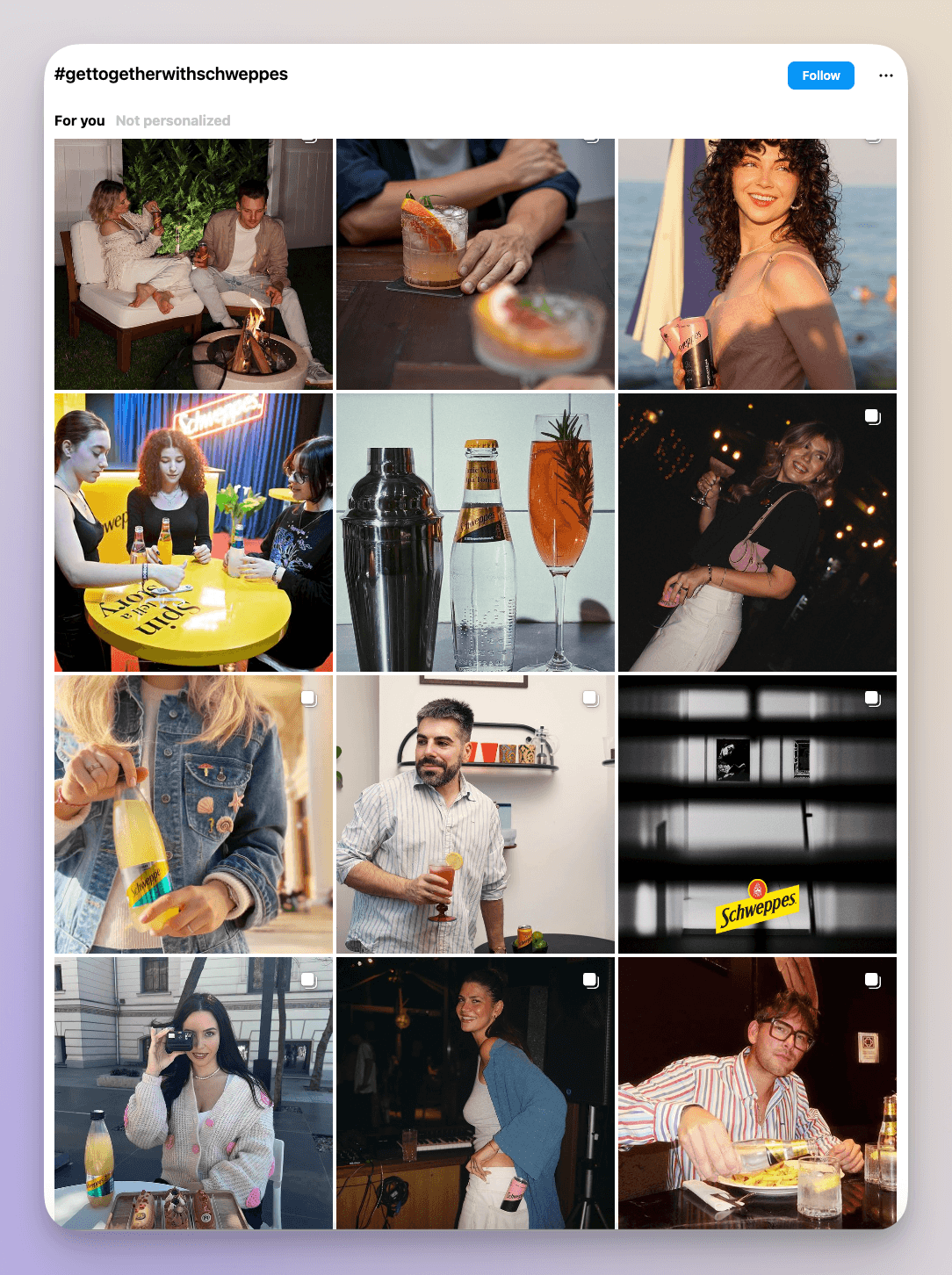
With tools like Socialinsider, you gain the ability to dive deep into your campaign’s social media analytics.
This way, you can analyze follower growth, engagement, and social media reach to see how each influencer’s contribution impacted the campaign.
For example, Socialinsider allows you to identify specific moments when follower growth spiked.
In Schweppes Romania’s case, if you correlate these increases with the timing of influencer posts, you'll observe a substantial 10%+ growth over the last 6 months.
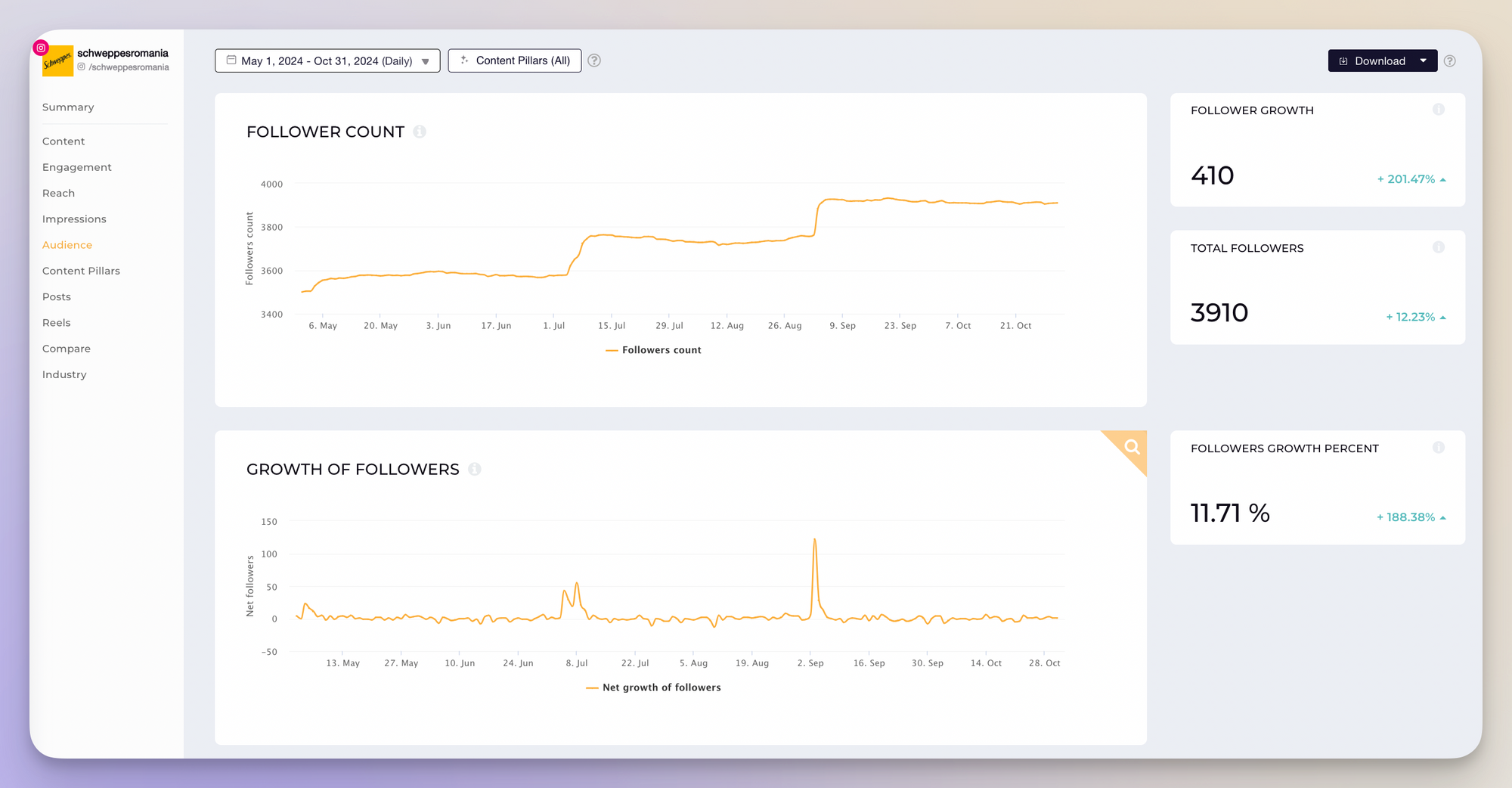
Additionally, you can view and compare the performance of all influencers involved, assessing each one’s reach and engagement to determine who drove the most interaction.
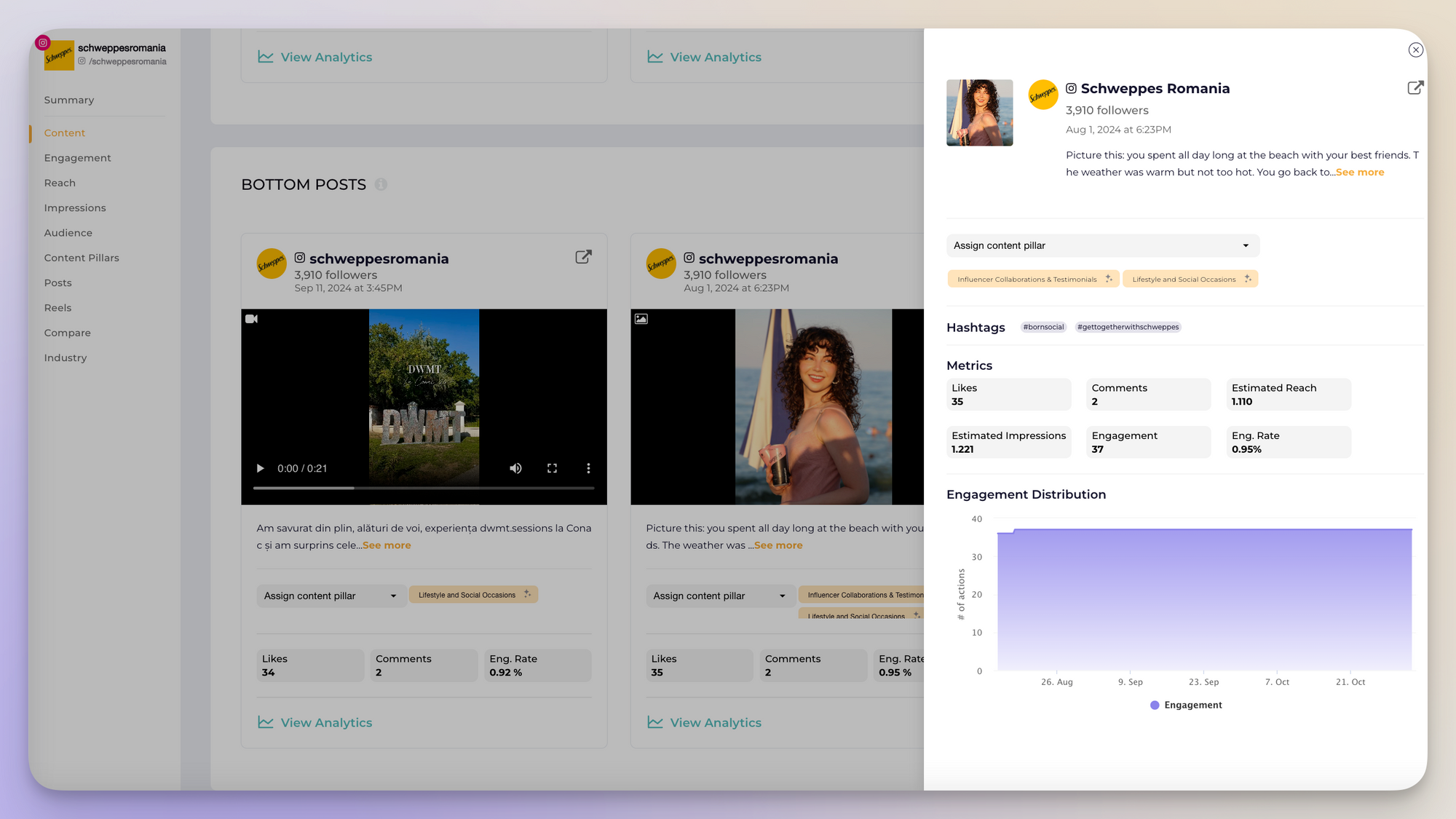
This granular insight lets you understand which influencers were most effective and enables you to optimize future campaigns by focusing on the strategies and individuals who delivered the best results.
Popular platforms for influencer marketing
When it comes to crafting an effective influencer marketing strategy, choosing the right platform is key.
Here are two of the most popular influencer marketing channels where creators thrive, and where your brand can reach its ideal audience in authentic, engaging ways:
TikTok
TikTok has taken the influencer marketing world by storm, with its fast-paced, highly visual content.
The platform’s algorithm promotes discoverability, making it easier for influencers—both macro and micro—to reach potential new followers and create authentic content that resonates with their audience.
Instagram remains the most established and trusted platform for using influencers for marketing.
The platform is particularly suited to influencer collaborations for several reasons:
- Instagram is perfect for visual storytelling: The platform’s emphasis on high-quality images and videos aligns perfectly with influencer marketing trends, which relies on engaging visuals to showcase products. This visual appeal makes it easy for brands to highlight their products in an authentic, aesthetically pleasing way.
- So many ways to create unique content: Instagram provides multiple content formats, including Feed posts, Stories, Reels, and even Instagram Live, which enables influencers to create dynamic and varied content. This versatility allows for creative social media influencer campaigns, from quick product highlights in Stories to more immersive experiences in Reels and Live sessions.
- Engagement features make fans feel involved: Instagram’s interactive features like polls, question boxes, and Swipe Up links in Stories foster strong engagement. Influencers can encourage followers to participate directly, making collaborations feel like two-way conversations rather than one-sided advertisements. This results in better engagement and loyal followers for both the influencer and the brand.
- Targeting the right people and gather insights: With Instagram’s social media insights and advertising tools, brands can work with influencers to reach highly specific audiences based on demographics, interests, and behaviors. This ensures that influencer content is shown to the most relevant audience, maximizing impact.
- Build trust through community: Instagram has built a reputation for community-building, where influencers create genuine relationships with their followers. This trust translates well into brand collaborations, as followers view influencer recommendations as more authentic and credible than traditional ads.
Influencer marketing best practices
Now that you've nailed down the basics of how to build an influencer marketing strategy, it's time to dive into the essentials—the best practices for influencer marketing.
Here are the top influencer marketing tips you need to keep on your radar to maximize your impact and reach.
Use an influencer management app to connect with relevant influencers
If you're wondering how to manage influencers effectively, an influencers management app may just be the secret weapon you needed.
As you already know, influencer marketing relies on building authentic relationships with people who genuinely resonate with your brand.
But finding and connecting with the right individuals can take a lot of time and effort.
So that's where a social media influencer management app steps in, helping you easily identify the most relevant influencers and streamline communication, making collaboration smoother than ever.
These tools keep everything in one place, from outreach to planning, letting you focus on creating standout campaigns that build trust and boost your brand's visibility.
Create a clear collaboration structure
To effectively start a social media campaign with an influencer, it’s crucial to establish a clear collaboration structure that defines roles, timelines, and expectations for both parties.
This includes setting up a communication flow that guides each stage of the campaign.
For instance, establish a deadline for the influencer to submit initial content ideas or post drafts, allowing time for your team to review and provide feedback.
Specify how many days are allocated for revisions and outline when final approvals are expected.
This structured approach creates a predictable process, so both you and the influencer know exactly what needs to happen and when.
By breaking down each step—from initial proposals to final approval—you can avoid misunderstandings and ensure a smooth, productive partnership.
Additionally, according to Influencer Marketing Hub, here are some essential components to include:
Payment terms: Outline the payment structure, including the amount, payment schedule, and whether it’s upfront, upon completion, or divided into installments.
Sponsored hashtags: Ensure compliance with social media advertising regulations by specifying a hashtag, such as #ad or #BrandPartnership. This not only builds transparency with the audience but also protects both parties legally.
Campaign goals: Communicate the overall goals of the campaign to the influencer so they understand the intended impact—whether it’s raising brand awareness, boosting engagement, or driving sales. This shared understanding allows them to tailor content accordingly.
Set a trial period for long-term influencer partnerships
For a lasting influencer collaboration, start with a trial period to assess if each creator is the right one for an impactful, sustainable partnership.
And here’s why this approach ranks among the smartest influencer marketing strategies:
- Finding the right fit: If you intend to work with influencers on the long term, starting with a trial campaign lets you see if their tone, values, and audience really align with your brand. It’s your chance to ensure they can represent your brand authentically and professionally.
- Seeing real results: Working with influencers isn't just about follower counts; it’s about impact. This trial period allows you to assess how well the influencer engages their audience with your brand, from conversions to audience interaction. For a sustainable collaboration, only influencers who drive real results should move forward.
- Testing the compatibility between parts: When working with influencers, communication and reliability are everything. The trial lets you gauge how seamlessly the collaboration flows, checking if they’re responsive and committed.
- Spotting potential ambassadors: If your goal is to find influencers who could eventually become brand ambassadors, this trial phase is critical. It’s a perfect way to build rapport, set expectations, and see who’s genuinely excited to represent your brand.
By implementing a trial period, you’re identifying those with the potential to grow with your brand and deliver meaningful results over time.
Influencer marketing: mistakes to avoid
Here’s what every savvy social media strategist must dodge when planning their next influencer marketing campaign.
Not setting goals expectations
Working with influencers without setting clear collaboration goals—like a target percentage increase in sales—can cause you to lose sight of the campaign’s purpose.
This lack of direction makes it difficult to assess what’s working and what’s not, and it may even lead to wasted resources or negative returns.
Clear objectives help keep the campaign focused and ensure that your investment pays off.
Lacking clear content guidelines
Lacking clear content guidelines when working with influencers can lead to inconsistent messaging and potential brand misalignment.
Without specifying the type of post—such as a story, video, or image—and any scenarios or terms to avoid, influencers may unintentionally create content that doesn’t align with the campaign’s goals or brand values.
This ambiguity can result in posts that feel off-brand or, worse, associate the brand with situations or language that may harm its image.
Clear guidelines ensure that social media influencers know the expected format and any red lines, creating a more cohesive campaign that resonates with the audience while protecting the brand's reputation.
Over-controlling influencer content
Being too controlling of what a social media influencer posts diminishes the very spark that makes influencer partnerships work.
When brands try to micromanage every detail, the content often ends up feeling stiff and forced, losing the natural style that the influencer’s followers are there for.
This not only disrupts the influencer’s unique connection with their audience but can make the brand come across as too rigid or out of touch.
Instead, giving influencers some creative room keeps the content authentic, allowing them to bring your campaign to life in a way that feels real and engaging.
Top influencer marketing campaign examples
From viral moments to creative collaborations, these brands have mastered the art of connecting through influence.
So dive in and explore these standout examples of influencer marketing campaigns that took social media by storm.
Dyson
Dyson masterfully uses influencer marketing to promote its wide-ranging product lineup, from the iconic Airwrap and air purifiers to headphones and vacuums.
Through the #DysonPartner tag, influencers showcase how Dyson products seamlessly fit into their daily routines, turning ordinary tasks into elevated experiences.
By sharing authentic moments—like purifying the air when you have pets, tackling deep cleaning with Dyson vacuums, or experimenting with hairstyling at home—these partnerships demonstrate the real-life value and versatility of Dyson’s innovations.
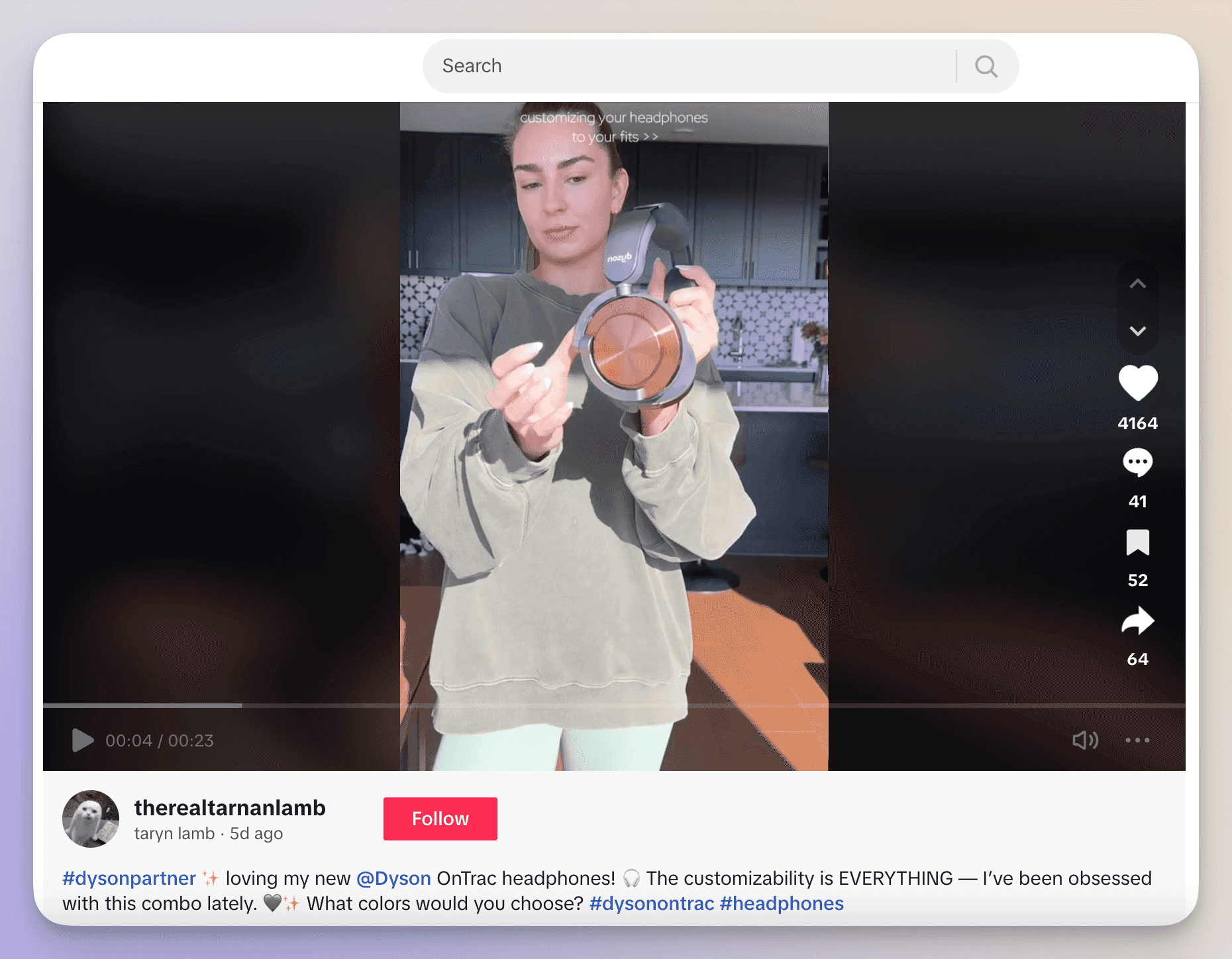
NA-KD
NA-KD is setting the standard in influencer marketing by not only partnering with top fashion and lifestyle influencers but involving them directly in its creative process.
Through a series of strategic, high-impact collaborations, NA-KD co-creates collections that reflect both the brand’s style and the influencer’s unique personality.
By allowing influencers to actively participate in the design and development of their collections, NA-KD transforms traditional paid partnerships into dynamic, co-branded experiences.
This approach creates a genuine connection between influencers and the products, which followers can feel and trust.
As influencers showcase these exclusive designs in visually captivating content, NA-KD taps into the aspirational lifestyle that social media audiences crave, amplifying reach and engagement far beyond standard promotional posts.
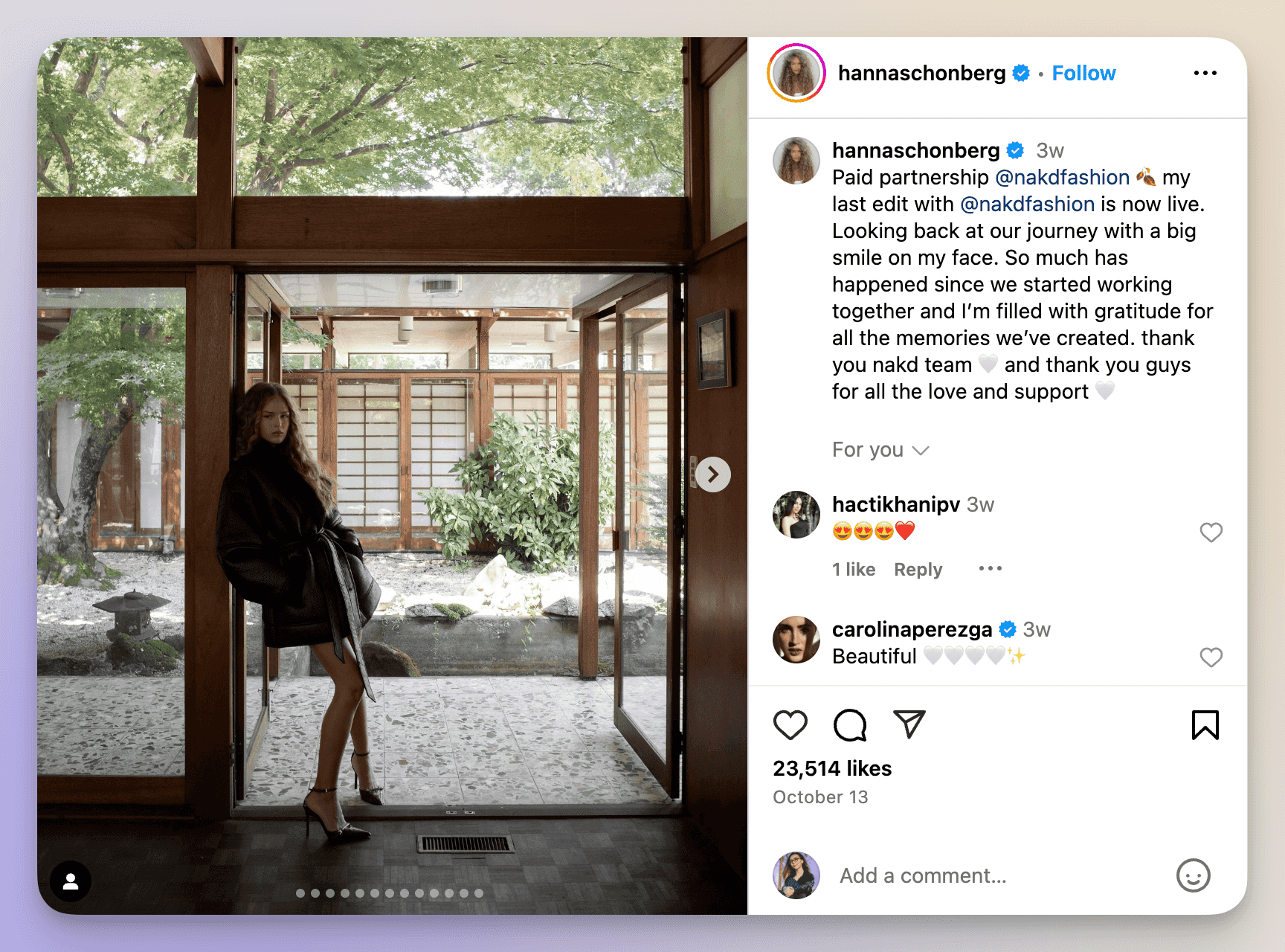
NA-KD’s collaborations often include launch announcements, exclusive previews, and behind-the-scenes glimpses, all designed to build anticipation and spark FOMO among followers.
Ultimately, NA-KD proves that influencer marketing can be more than just sponsored posts—it’s about co-creating moments that make their brand a cultural phenomenon.
Gisou
Gisou’s Mini Fridge campaign has become a TikTok sensation, harnessing the platform’s viral power to spread quickly and reach massive audiences.
TikTok’s format allows influencers to share these unique, exclusive moments in short, engaging videos that are perfect for sparking FOMO among viewers.
By gifting influencers a beautifully curated mini fridge stocked with Gisou products, the brand taps into TikTok’s hottest trends—aspirational, eye-catching, and highly shareable.
As followers watch influencers unbox and display this enviable gift, they’re drawn into the hype, amplifying Gisou’s brand reach and solidifying its position as a must-have, exclusive beauty brand.
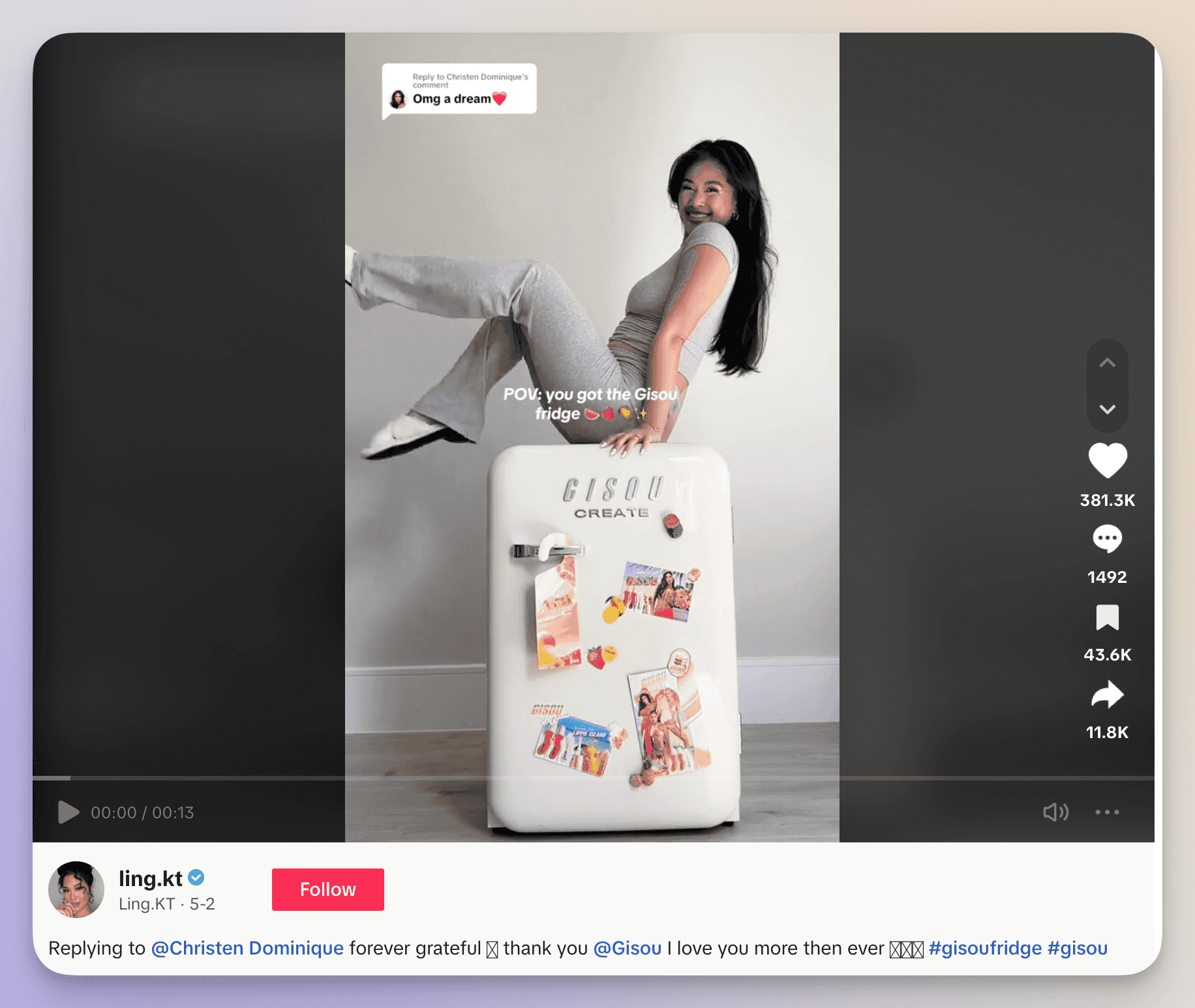
Ultimately, the campaign elevates Gisou's products from desirable beauty items to symbols of an aspirational lifestyle, making the brand something that everyone wants but only a select few can experience firsthand.
Final thoughts
Now that you’re equipped with the tools to understand how influencer marketing works and how to create an influencer marketing strategy, all that's left is to dive in, connect with the right voices, and let your brand story shine through authentic partnerships.
FAQs on influencer marketing
What are some pros and cons of influencer marketing?
Influencer marketing offers several advantages, like boosting brand awareness, building credibility, and directly reaching niche audiences, yet it also comes with drawbacks. Costs can be high, controlling brand message is challenging, and measuring ROI can sometimes be difficult.
How do you track influencer marketing campaigns?
Tracking influencer marketing campaigns involves using UTM codes and affiliate links to track traffic and conversions, platform analytics for reach and engagement, influencer insights for audience data, and custom campaign hashtags to monitor mentions and engagement.
What KPIs are most important to track when doing an influencer marketing campaign?
Key KPIs to monitor include engagement rate (likes, comments, shares), reach and impressions (for campaign visibility), conversions (tracking leads or sales), and ROI (revenue compared to cost), offering a clear snapshot of campaign impact and effectiveness.
Analyze your competitors in seconds
Track & analyze your competitors and get top social media metrics and more!
You might also like
Improve your social media strategy with Socialinsider!
Use in-depth data to measure your social accounts’ performance, analyze competitors, and gain insights to improve your strategy.
